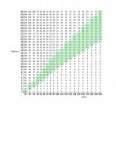jason.fink
New member
- Joined
- May 26, 2015
- Messages
- 1
To make a long problem short, I am working with annealing plastic, and the thicker the plastic the longer the annealing time per inch of plastic. The problem is to find alike material to anneal together. But the annealing time has a MAX and MIN annealing time per inch of material thickness to create the range of "LIKE" thicknesses. The current rule is MIN (1 inch = 10 hours) and MAX (1 inch = 15 hours) or 10x <= y <= 15x, where x equals the thickness of product and y are all potential thicknesses. When this is drawn on a grid, it creates a parabola, starting at (0,0) in Quadrant I. The X axis is time and the Y axis is thickness. As thickness increases, the time increases in equal increments. The only calculations I can derive from this is that MAX is 15/10x = y, where x is the thickness, and MIN is 10/15x = y.
The image below illustrates the range and parabola. Thickness on the Y axis, a green cell on the linear line per thickness shows it's possible annealing times. Hours on the X axis, a green cell on a linear line per hour shows all possible thicknesses annealed for that time.

I'm too far removed from my high school trig and algebra to draw this formula up as quickly as I want, and was hoping for some help. I could calculate this if it were a linear function without a range, but that's where I'm currently hung up and think a standard parabolic formula would solve my issue. Any insight or help is appreciated.
- Jason
The image below illustrates the range and parabola. Thickness on the Y axis, a green cell on the linear line per thickness shows it's possible annealing times. Hours on the X axis, a green cell on a linear line per hour shows all possible thicknesses annealed for that time.

I'm too far removed from my high school trig and algebra to draw this formula up as quickly as I want, and was hoping for some help. I could calculate this if it were a linear function without a range, but that's where I'm currently hung up and think a standard parabolic formula would solve my issue. Any insight or help is appreciated.
- Jason
